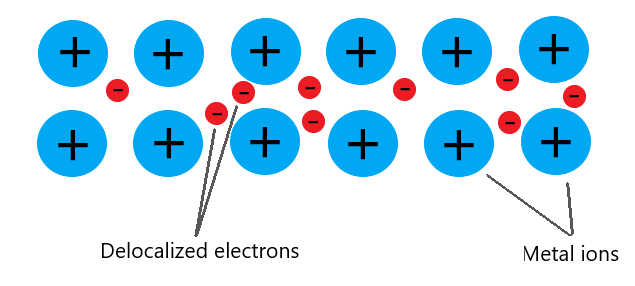Charge (Q) 🔗
- In Physics the symbol for charge in equations is $q$ or $Q$.
- Unit: Coulombs (C) (amount of electrical charge)
- We use it to describe how positive or negative an object is.
Pātai: What is a Coulomb? 🔗
- We know that electrons are negatively charged. In fact, they have a charge of $-0.000,000,000,000,000,000,16C$
- Pātai: Write this number in scientific form (e.g. $1\times10^{5}$)
Whakatika 🔗
- $q_{e} = -0.000,000,000,000,000,000,16 C =-1.6 \times 10^{-19}C$.
- Pātai: How many electrons are needed to carry $-1C$ of charge?
Whakatika 🔗
$$ \begin{aligned} num_{e} &= \frac{Q_{total}}{q_{e}} \newline num_{e} &= \frac{-1}{-1.6 \times 10^{-19}} \newline num_{e} &= 6,250,000,000,000,000,000 = 6.25 \times 10^{18} \end{aligned} $$
$6.25 \times 10^{18} electrons = -1 C$
$-1C$ is the amount of charge carried by $6.25 \times 10^{18}$ electrons.
Pātai 🔗
- If a balloon has charge of $-3C$ did the balloon lose or gain electrons, and how many?
- If Charlotte has charge of $0.2C$ did she lose or gain electrons and how many?
Whakatika Tahi 🔗
If a balloon has charge of $-3C$: did the balloon lose or gain electrons, and how many?
$$ \begin{aligned} & \text{Negative C} \rightarrow \text{electrons gained (-ve charge)} \newline & num_{e} = 3 \times (6.25 \times 10^{18}) \newline & num_{e} = 1.875 \times 10^{19} && \text{ electrons gained} \end{aligned} $$
Whakatika Rua 🔗
If Charlotte has charge of $0.2C$ did she lose or gain electrons and how many?
$$ \begin{aligned} \text{Positive C} &\rightarrow \text{electrons lost (+ve charge)} \newline num_{e} &= 0.2 \times (6.25 \times 10^{18}) \newline num_{e} &= 1.25 \times 10^{18} \text{ electrons lost} \end{aligned} $$
Conductors 🔗
- A conductor is a material through which charge can move freely
- E.g. Metals because they have a delocalised sea of electrons
- Have equal distributions of charge

Insulators 🔗
- A material through which electrons cannot easily flow
- The electrons encounter a large friction force when trying to move
- This friction causes heat to build up
- e.g. Wood can catch fire if current is applied
- Can have uneven distributions of charge
Task/Ngohe 🔗
Homework Booklet Q1a
Insulators Experiment 🔗
- Collect a Pencil Burning experiment sheet
- Complete Task 1 and 2 in small groups using a hard mat to protect your bench
Current 🔗
- Current is the flow of charge (often electrons).
- It is the measure of the rate at which the charge flows (Amperes).
- Recall: $1C$ of charge is $6.25\times10^{18}$ electrons
$$ \begin{aligned} & I = \frac{q}{t} \newline & \text{I = current measured in what?} \newline & \text{q = charge measure in what?} \newline & \text{t = time measured in what?} \end{aligned} $$
Pātai 🔗
- If $10A$ flows through a wire, how much charge passes a point in $5s$?
- A total charge of $0.12C$ passes a point in $5s$. What is the current?
- $0.02C$ of charge passed through a resistor in 1 minute. What was the current?
- If the current is $0.3A$, how much charge will pass a point in 10 minutes?
$$ \begin{aligned} & && \text{(K)} \newline & && \text{(U)} \newline & && \text{(F)} \newline & && \text{(S+S)} \end{aligned} $$
Whakatika Tahi 🔗
$$ \begin{aligned} I &= 10A, t=5s && \text{(K)} \newline q &= ? && \text{(U)} \newline I &= \frac{q}{t} && \text{(F)} \newline 10 &= \frac{q}{5} && \text{(S+S)} \newline q &= 10 \times 5 = 50C \end{aligned} $$
Whakatika Rua 🔗
$$ \begin{aligned} q &= 0.12C, t=5s && \text{(K)} \newline I &= ? && \text{(U)} \newline I &= \frac{q}{t} && \text{(F)} \newline I &= \frac{0.12}{5} && \text{(S+S)} \newline I &= 0.024A \end{aligned} $$
Whakatika Toru 🔗
$$ \begin{aligned} q &= 0.02C, t=60s && \text{(K)} \newline I &= ? && \text{(U)} \newline I &= \frac{q}{t} && \text{(F)} \newline I &= \frac{0.02}{60} && \text{(S+S)} \newline I &= 0.00033A \end{aligned} $$
Whakatika Whā 🔗
$$ \begin{aligned} I &= 0.3A, t=600s && \text{(K)} \newline q &= ? && \text{(U)} \newline I &= \frac{q}{t} && \text{(F)} \newline 0.3 &= \frac{q}{600} && \text{(S+S)} \newline q &= 0.3 \times 600 = 180C \end{aligned} $$
What Direction Does Current Flow? 🔗
Conventional Current 🔗
- Back in the old days they thought current was the flow of positive charge, but these days we know it is the flow of negative charge
- This is because protons (positive) are fixed inside the nucleus of an atom and nuclei cannot move, whereas electrons (negative) can move freely in some materials
- Conventional current is the direction that positive charges move in a circuit. From the positive terminal to the negative terminal.
- However, electrons actually move from the negative terminal to the positive terminal, which is opposite to conventional current.
